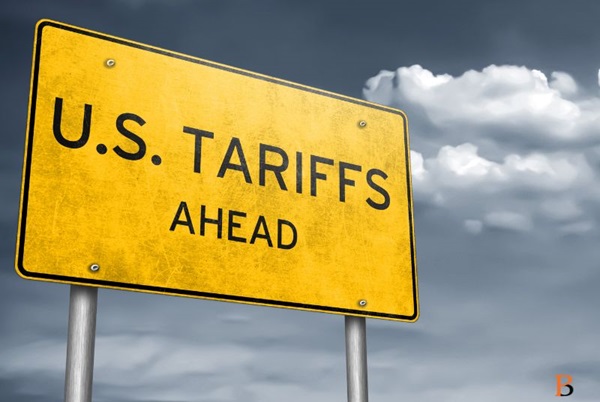.png)

Ajay Srivastava, founder of Global Trade Research Initiative, is an ex-Indian Trade Service officer with expertise in WTO and FTA negotiations.
August 5, 2025 at 5:19 AM IST
India’s exports to the United States, its largest trading partner, are facing sharp disruption. A 25% country-specific tariff, combined with an additional unspecified penalty, threatens to undercut India’s competitive position. In contrast, regional rivals like Vietnam, Bangladesh, and Mexico continue to enjoy lower or zero tariffs.
The new US tariff regime exempts only a few sectors, pharmaceuticals, energy products, critical minerals, and semiconductors. Outside these, nearly every major Indian export faces pressure. Exports to the US are projected to drop by nearly 30%, from $86.5 billion in 2024–25 to $60.6 billion in 2025–26.
India’s garment exports, particularly knitted and woven categories, are heavily exposed. Each segment, worth $2.7 billion annually, now faces US tariffs of 38.9% and 35.3%, respectively. That’s significantly higher than rates for Vietnam, Bangladesh or Cambodia.
Made-up textiles like towels and bedsheets, which bring in $3 billion, half of which goes to the US, now face a 34% duty, putting India at a clear disadvantage to Pakistan and Vietnam.
India’s $2 billion shrimp exports, representing 32% of global supply, will now face a 25% tariff. This wipes out their price edge over competitors like Canada and Chile, both of which benefit from US free trade agreements.
Thin Margins
Jewellery, another high-value export segment, will feel a direct hit. Of the $10 billion India exports globally, 40% heads to the US. With jewellery now facing a 27.1% duty, margins, already thin at 3–4%, are under stress. Mechanical gold jewellery, worth $3.6 billion in exports to the US, is especially vulnerable.
Metal exports worth $4.7 billion, including steel, aluminium and copper, are also at risk. The higher cost from tariffs could weaken demand from US infrastructure and energy buyers.
Engineering goods are similarly exposed. India exports $6.7 billion in machinery and $2.6 billion in auto parts to the US, which will now face over 26% tariffs. In contrast, Mexico pays no duty, and Japan faces just 15%.
Petroleum exports worth $4.1 billion remain tariff-free for now. But India's continued use of Russian crude could bring further scrutiny and penalties.
Pharmaceuticals exports worth $9.8 billion and smartphones shipments of $10.6 billion are currently exempt, but not necessarily safe. US President Trump has warned of possible tariffs on Indian medicines and tougher rules on electronics involving Chinese components.
Uneasy Global Backdrop
Finding other export markets to offset US losses won’t be easy. Global trade is shifting away from openness, with more countries adopting restrictive policies tied to security, politics and climate.
The European Union, India’s second-largest trading partner with imports of $75.7 billion, is introducing a carbon border tax in January 2026. Indian steel and aluminium are already less competitive due to new documentation rules, contributing to a 24.4% drop in EU-bound exports this year.
More challenges are coming. The EU’s deforestation law will impose new taxes on farm goods, potentially hitting a wide range of Indian agricultural and industrial exports.
As the US and EU toughen market access, more countries may follow suit.
Export Strategy
In response to this challenging environment, the Global Trade Research Initiative has proposed a five-point plan to stabilise and future-proof Indian exports:
1. Revive the Interest Equalisation Scheme
This export credit support scheme, discontinued last year, was a low-cost but high-impact tool. GTRI recommends relaunching it with a ₹150 billion annual budget and a five-year commitment. Subsidised loans could give MSME exporters a vital cost advantage.
2. Build a Real-Time Export Helpdesk
Small exporters struggle with outdated or overly complex dashboards. A digital and phone-based helpdesk could provide up-to-date information on tariffs, documentation and regulatory hurdles in key markets like the US.
3. Use FTAs Strategically—but Manage Expectations
GTRI supports rapid implementation of the India–UK FTA and faster EU talks. Still, it cautions that most Indian exports already enter key markets duty-free or at low tariff levels of 3–4%. Tariff reductions may not yield major export gains, and past FTAs suggest imports from partners tend to outpace Indian export growth.
4. Reimagine Tourism as a Strategic Export Sector
India earned just $17 billion from foreign tourists in 2023—far behind Spain at $92 billion, Dubai at $31 billion, and Amsterdam at $31 billion. The issue is not attractions, but deterrents: high hotel taxes, harassment, and poor transport. Addressing these can unlock major export and employment potential.
5. Onboard New Exporters with a Unified Trade Network
A National Trade Network could simplify compliance and export onboarding. GTRI estimates this could bring over 200,000 new MSMEs into the trade ecosystem, helping India diversify its export base and withstand global headwinds.
In today’s volatile global trade environment, resilience depends not only on price competitiveness but also on policy agility. GTRI’s strategy offers a timely roadmap for navigating this turbulence. Whether the government can act quickly enough remains the critical question.




